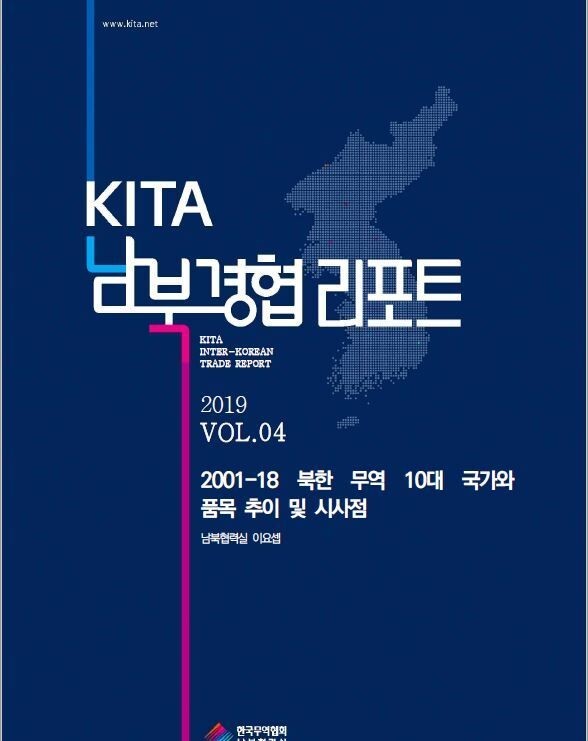hankyoreh
Links to other country sites 다른 나라 사이트 링크
N. Korea’s trade dependence on China has increased to 90% over last 3 years

North Korea’s dependence on trade with China has continued to increase since the 2000s, with China representing 90% of all North Korean trade in 2018, a report shows. The situation is the result of a deepening imbalance in North Korea’s trade relationships since 2016 in the wake of the Kaesong Industrial Complex’s closure and intensifying international sanctions.
An inter-Korean economic cooperation report titled “Trends in North Korea’s Top Ten Trade Partners and Items and Their Implications, 2001-2018,” published by the Korea International Trade Association (KITA) on Dec. 1, showed China’s proportion of North Korean trade rising by 5.3 times from 17.3% of dollar value in 2001 to 91.8% as of last year. North Korea’s trade with South Korea, which ranked second among its trade partners at 25.0% in 2010, came to a complete halt with the 2016 closure of the Kaesong Complex. Trade with Japan, which ranked first among North Korean trading partners by dollar value at 30.1% in 2001, has also been suspended since 2007 amid independent economic sanctions by Tokyo.
“North Korea’s trade with South Korea, China, and Japan has operated under a competitive structure rather than a complementary one,” the report observed.
“Trade with South Korea and China increased after trade with Japan rapidly declined due to the abductee issue and security-related ‘catch-all’ regulations; transactions with China rose sharply after inter-Korean trade was halted with South Korea’s May 24 measures in 2010; and [North Korea’s] trade dependence on China reached 90% after even the Kaesong Complex was closed in 2016,” it concluded. As of 2018, countries besides China accounted for only small percentages of North Korea’s trade, with India at 1.4% and Russia at 1.3%. Between 2001 and 2018, the top 10 countries by average percentage of North Korean trade were China (50.3%), South Korea (17.8%), India (4.7%), Japan (3.4%), Thailand (2.7%), Brazil (2.4%), Russia (1.9%), Germany (1.2%), Singapore (1.0%), and Saudi Arabia (1.0%).
North Korea’s top-ranked export items over the same period were chiefly minerals sold for foreign currency and toll processing-based garments produced with inexpensive labor, including anthracite (18.8%), iron ore (4.2%), men’s cold-weather coats (2.1%), and women’s cold-weather coats (1.7%). Its top-ranked imports were chiefly petroleum products, including crude oil (7.2%), heavy oil (3.7%), and kerosene (3.6%). Anthracite disappeared from the ranking list after its inclusion as a target in intensified sanctions last year, while items such as watches, ferrosilicon, wigs, injection machinery, and tungsten rose on the export ranking. The top import item was soybean oil, followed by nitrogen fertilizer, synthetics, and wheat flour.
“Over the past 18 years, North Korea’s trade partners and items have been observed to change with the external political situation,” a KITA official said.
“As sanctions on North Korea are loosened or lifted in the future, trade with countries such as South Korea, Japan, and India that accounted for a lot of transactions in the past is very likely to increase, “ the official predicted.
“In particular, some of South Korea and Japan’s chemical, electronic, and machinery products are superior to China’s, so there will be a lot of demand in North Korea.”
By Kim Eun-hyoung, staff reporter
Please direct comments or questions to [english@hani.co.kr]

Editorial・opinion
![[Column] Season 2 of special prosecutor probe may be coming to Korea soon [Column] Season 2 of special prosecutor probe may be coming to Korea soon](https://flexible.img.hani.co.kr/flexible/normal/500/300/imgdb/original/2024/0426/3317141030699447.jpg) [Column] Season 2 of special prosecutor probe may be coming to Korea soon
[Column] Season 2 of special prosecutor probe may be coming to Korea soon![[Column] Park Geun-hye déjà vu in Yoon Suk-yeol [Column] Park Geun-hye déjà vu in Yoon Suk-yeol](https://flexible.img.hani.co.kr/flexible/normal/500/300/imgdb/original/2024/0424/651713945113788.jpg) [Column] Park Geun-hye déjà vu in Yoon Suk-yeol
[Column] Park Geun-hye déjà vu in Yoon Suk-yeol- [Editorial] New weight of N. Korea’s nuclear threats makes dialogue all the more urgent
- [Guest essay] The real reason Korea’s new right wants to dub Rhee a founding father
- [Column] ‘Choson’: Is it time we start referring to N. Korea in its own terms?
- [Editorial] Japan’s rewriting of history with Korea has gone too far
- [Column] The president’s questionable capacity for dialogue
- [Column] Are chaebol firms just pizza pies for families to divvy up as they please?
- [Column] Has Korea, too, crossed the Rubicon on China?
- [Correspondent’s column] In Japan’s alliance with US, echoes of its past alliances with UK
Most viewed articles
- 1After election rout, Yoon’s left with 3 choices for dealing with the opposition
- 2AI is catching up with humans at a ‘shocking’ rate
- 3Noting shared ‘values,’ Korea hints at passport-free travel with Japan
- 4Why Kim Jong-un is scrapping the term ‘Day of the Sun’ and toning down fanfare for predecessors
- 5Two factors that’ll decide if Korea’s economy keeps on its upward trend
- 6South Korea officially an aged society just 17 years after becoming aging society
- 7Korea’s 1.3% growth in Q1 signals ‘textbook’ return to growth, says government
- 8Is Japan about to snatch control of Line messenger from Korea’s Naver?
- 91 in 5 unwed Korean women want child-free life, study shows
- 10[Reportage] On US campuses, student risk arrest as they call for divestment from Israel